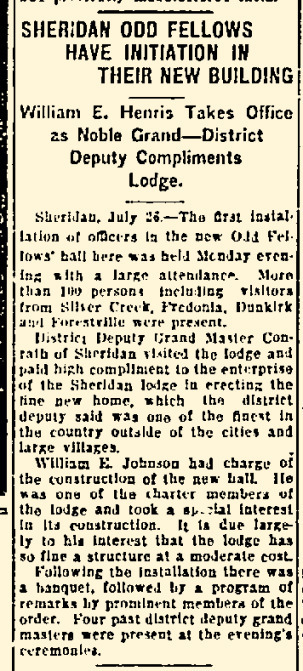The Sheridan Historical Center was built by local members of the Independent Order of the Odd Fellows (IOOF) beginning in 1927. A nationwide fraternal and charitable organization dating back to 1819 in the U.S., the ‘Odd Fellows’ had a robust membership in Sheridan when the hall was erected. From the beginning, IOOF members hoped the building would benefit the larger community and be a source of local pride. The first floor was large enough for community dances, dinners, and parties. The second floor was reserved for lodge members. Through the years, other groups also used portions of the hall through rental agreements with the IOOF. These included the Rebekahs (the sister lodge of the IOOF, for women only), Sheridan firemen, private parties, and town officials. In the early 1960s, when membership in the IOOF and Rebekahs was waning, then town historian Glenna C. Niebel wrote the history of the building that follows. In 1973, the remaining IOOF members donated the property to the Town of Sheridan, which renovated the premises and used it for its municipal offices until moving to the current municipal complex on the site of the former St. John Bosco Church. The historical society purchased the property from the Town in late 2015. The society was the sole bidder.
GLENNA NIEBEL’S HISTORY OF THE IOOF HALL, CIRCA 1960
“When the Sheridan IOOF Lodge was instituted, they met on the third floor of the building now owned by the Ford Tucker Family [presently G ’n G Country Store]. That floor has since been removed.
From the very first, the Lodge flourished and grew in numbers. In time they outgrew these first quarters and too, it was becoming difficult for some of the older members to climb the two flights of stairs. So the dream of a new building of their own took root and rapidly interest and enthusiasm built up until a meeting was called to take some action. The first meeting to organize the IOOF Building Association was held at the home of Raymond Borthwick. Those in attendance were: George Kricheldorf, Claude Luce, and Rollin Snow who acted as attorney, with R.D. Borthwick acting as Secretary. At this meeting they took an option on the corner lot … [at the northwest corner of U.S. Route 20 and Center Road]. In 1927, to raise funds, they had an auction … with Clinton Daley acting as auctioneer. They sold mostly farm machinery, a lot of which would be a curiosity to this generation. When work finally got underway, no contract was let but the plans were drawn up and the work laid out by William Johnson, a master carpenter and an ardent Odd Fellow, being a loyal member of the Sheridan Lodge. He had an able assistant in another loyal carpenter member, Harvey M. Bailey. It was planned to have the work done by the members who donated their labors so anxious and enthusiastic were they to have a Lodge Hall of their own. Some of those who gave a lot of their time to the project were James I. Patterson, Lewis Strawser, John Bowyer, John Griswold, Arden Griswold, Frank Kruse, George Henris, R.D. Borthwick, Will Henris, Glen Scott, Mayman Gilray, Hugh Gilray, Leonard Gilray and Henry Niebel and probably many others who helped from time to time. The work proceeded remarkably well but owing to their lateness in starting, it ran into winter before the roof was on. There came a bad snow storm which filled the upper floor with 18 inches of snow. In order to get the snow out, they had to build a scaffold and use two crews, one on the floor and one on the scaffold. We are indebted to Lewis Strawser for this information, as he helped remove the snow. When it came time to put on the roof, winter had really set in and the temperature was below zero. The nails had to be heated in order for the men to handle them without gloves. Undaunted by this and other hardships they carried their dream to completion and at long last the day for moving from their first home to a new one of their own building arrived. This was the day to which they had all looked forward and many were on hand to help with the task. By nightfall, tired but happy, they were installed in their new home and the dream of those whose vision and foresight had inspired the undertaking was at last a reality. All went smoothly until the depression of 1929. From that time until 1949 when they celebrated the burning of the mortgage, it was one continuous struggle. Often times bills were paid only through the generosity of certain members who dipped into their own pockets. At one time, Glen Scott advanced $300 and after his death, his widow Mrs. Jessie Scott, offered to give that to the Building Association if they could raise the remainder of their indebtedness. This they were able to do and in 1949 they cleared the debt and their dream of their own Lodge Hall free from indebtedness was realized. In 1953 Sheridan IOOF Lodge celebrated its Fiftieth Anniversary. To us those pioneering Odd Fellows have left a building free of debt. Yet we are experiencing a great struggle to maintain and hold possession of it. Are we to break faith with those who labored so hard to make it a reality?”
